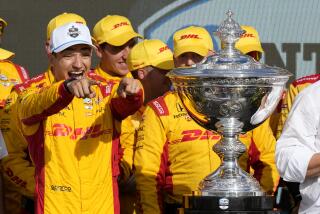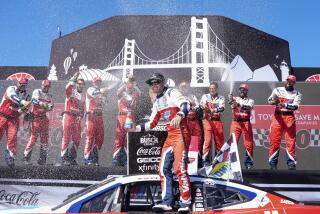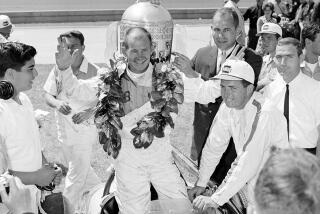NASCAR: It’s bigger than the South
Glance at the dozen drivers in this year’s NASCAR Chase for the Sprint Cup playoff and one might never guess that NASCAR has its roots in the South.
Reigning champion Jimmie Johnson is a Californian. Kurt Busch is from Nevada. Tony Stewart hails from Indiana and Carl Edwards from Missouri. Juan Pablo Montoya did grow up south of the Mason-Dixon line, but he’s not from the land of Dixie, he’s from Colombia.
Mark Martin is from Arkansas and Denny Hamlin is a Virginian, but most drivers in the Sprint Cup Series are no longer Southern natives as was the case in NASCAR’s first four decades.
Until that change occurred, passionate NASCAR fans knew that Level Cross, N.C., meant Richard Petty; Kannapolis, N.C., meant Dale Earnhardt; and “The Alabama Gang” meant Bobby and Donnie Allison, Neil Bonnett and others.
“I’m certainly resistant” to the change “because I am a Southern boy,” quipped Bobby Allison, who retired in 1988 after winning 84 NASCAR Cup races. “But it’s a product of the incredible interest in NASCAR Cup racing not only in the other states but around the world.”
Yet as the series arrives for Sunday’s Pepsi 500 at Auto Club Speedway in Fontana, the fourth race in this year’s Chase, how exactly did drivers from beyond the South eventually dominate NASCAR’s premier ranks?
The evolution paralleled NASCAR’s overall expansion in popularity in the last two decades. Until then, NASCAR largely was a regional sport that was born in the South, as were its drivers, with races mostly in the South.
But starting in the early 1990s, a growing number of young drivers around the country sought careers in stock-car racing because NASCAR was growing. Its races started appearing on television every weekend, and later the sport expanded to new tracks in Fontana, Chicago, Kansas City, Las Vegas and Fort Worth.
According to Cup driver Matt Kenseth, the main catalyst for the change was the arrival in 1993 of a boyish-looking Californian named Jeff Gordon, who had moved to Indiana as a youngster initially to pursue a career racing Indy-style cars.
Gordon instead switched to stock cars and won his first NASCAR Cup race in only his second year, in 1994. And in 1995, he won the series championship at age 24 -- his first of four titles.
“When Jeff Gordon came along and did that good out of the box, I think that opened a lot of car owners’ eyes,” Kenseth said.
“He wasn’t from the South and he didn’t grow up racing stock cars, he grew up racing open-wheel cars. All of a sudden it was, whoa, there are other people out there that can do this besides the same group of guys from this area.”
Kenseth said Gordon’s success “gave more people, like me from Wisconsin, an opportunity.” And car owners, he said, decided “we need to start looking in other places.”
Gordon, now 38, said, “I’d be happy to say I played some part” in the evolution even if it was somewhat by accident.
“When I was racing in Indiana, around that area in the Midwest in midgets and sprint cars, I knew what NASCAR was and the Daytona 500, but I had no clue where else they went, what else they did, how competitive it was, what the cars were like to drive,” he said. “To me it wasn’t even on the map.”
That changed after he was introduced to NASCAR, and now young drivers are drawn to stock-car racing “because the sport has grown to the level of where we just want the most talented drivers that we can get,” Gordon said.
NASCAR Cup driver Michael Waltrip, who co-owns his Toyota race team Michael Waltrip Racing, said the geographic shift in talent actually started before Gordon joined the sport as other non-Southern drivers showed they could win.
The late Tim Richmond was from Ohio, and Geoff Bodine, from Chemung, N.Y., “came down South with some innovative ideas about cars and how to race them and set them up and win,” Waltrip said.
But Waltrip, who is from Owensboro, Ky., like his older brother, three-time Cup champion Darrell Waltrip, agreed that televised races nationwide was a key factor in drawing non-Southern drivers into the sport. “You could be from Bismarck, North Dakota, and turn on the TV and get excited about NASCAR,” he said.
And Michael Waltrip said that after Gordon arrived, owners in search of talented drivers realized that “instead of worrying about whether you’re from the South and an experienced veteran, it was, ‘Where’s our next kid coming from?’ ”
Gordon -- with 82 Cup wins and $106 million in race winnings alone in his career -- let out a modest laugh when it was suggested that while young drivers in the past might have dreamed of being the next Mario Andretti or A.J. Foyt, now they want to be the next Jeff Gordon.
But he didn’t dispute the idea.
“Seeing NASCAR on television and seeing that there aren’t just guys from North and South Carolina and Tennessee that are driving these cars, it did open up their eyes to pursue it,” he said.
And Gordon, still smiling, said many young drivers probably have said to themselves: “This Jeff Gordon guy seems to be doing all right, so surely I can do as good as or better than him.”
--
--
BEGIN TEXT OF INFOBOX
NASCAR north
Southern drivers once dominated NASCAR stock-car racing, but the sport’s surge in popularity drew drivers from around the country. Here are the 12 drivers in this year’s Chase for the Cup playoff listed by their current spot in the standings:
*--* DRIVER STATE/COUNTRY Mark Martin Arkansas Jimmie Johnson California Juan Pablo Montoya Colombia Tony Stewart Indiana Kurt Busch Nevada Denny Hamlin Virginia Jeff Gordon California Greg Biffle Washington Ryan Newman Indiana Carl Edwards Missouri Kasey Kahne Washington Brian Vickers North Carolina *--*
Source: NASCAR
More to Read
Go beyond the scoreboard
Get the latest on L.A.'s teams in the daily Sports Report newsletter.
You may occasionally receive promotional content from the Los Angeles Times.










